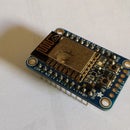Introduction: Raspberry Pi 3 - External Power for USB Ports
I wanted to use my Raspberry Pi 3 as a security camera. There are plenty of instructables around here how to do it.
But I run quickly into the problem that the power available on the USB ports wasn't sufficient for the two USB web cams that I wanted to use. The red power light started blinking, the WiFi got unreliable and I experienced shutdowns of the unit because the power supply of the Raspberry wasn't strong enough.
One solution would have been to just buy a powered USB hub and connect the two webcams to the hub. But I had some spare parts laying around and didn't want to spend extra money on the USB hub.
So I decided to check if I can build a cheaper solution with the spare parts I had.
Required parts:
- 1 small piece of prototyping PCB
- 2 USB female connector
- some pin headers
- spare 5V power supply
- some wires for the connections
Step 1: Investigation
I checked how the USB ports are soldered to the RPi and was very happy when I saw that there test points close to each USB port (see above picture) that I can use for my idea.
Each USB port has 3 test points for GND, D+ and D-, but not for +5V. But as I want to supply the USB ports from external anyway, that is perfect.
So i decided that I could connect my spare USB connectors directly to these test points and add an input for the external 5V supply.
Step 2: (kind of A) Schematic
All I have to do is to connect the test points on the RPi to the corresponding pins on the USB connectors.
The 5V supply pins on the USB connectors are then connected to the header where I want to connect the additional power supply.
2 important things:
- The GND line of the additional power supply and the GND line of the Raspberry Pi MUST BE CONNECTED
- The 5V of the additional power supply and the 5V of the Raspberry Pi MUST NOT BE CONNECTED
Step 3: The Making of ...
1) Solder the two USB connectors to the proto PCB. Keep the distance between the connectors the same as on the RPi. That makes it easier to connect between the proto PCB and the RPi board later.
2) Solder a 2 pin header (or whatever connector you want to use for the additional power supply) to the proto PCB
2) Solder 2 pieces of 3 pin headers to the test points on the RPi board
3) Remove the plastic part from the pin headers to keep the gap between the RPI board and the proto PCB as small as possible.
4) Solder the end of the pin headers to the proto PCB and connect them to the corresponding USB connector pins
5) Use wires to connect all GND points together. I made all of these connections on the bottom of the proto PCB. The metal housing of the USB connectors are GND as well.
6) Use wires to connect the 5V from the external power supply connector to the pins of the USB connectors. I made these connections on the top part of the proto PCB.
Check all wires and solder points that there is no unwanted connection between them or no missing connections.
Step 4: Finished
Now it's time for testing.
I plugged in my two web cams to the new USB connectors. Then I powered up the USB ports and then the RPi. Now I have no more power problems any more and my dual-camera RPi security camera system is ready to be assembled into a case and mounted in my front yard.
As you can see above I use a single USB power supply with multiple outputs instead of 2 separate power supplies. The one I use has a 5V 2.1A output to supply the RPi and a 5V 1A output to supply the web cams.
If you use 2 separate power supplies, connect the one which supplies the USB connectors first, and the one which supplies the RPi last. This way you can be sure that the USB web cams are powered up before the RPi starts.












